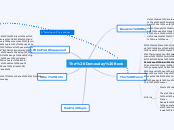`
Supply-Side policy
Types of Supply-Side policies
Market based
Supply-side policies are believed to achieve rapid growth, price stability and full employment at the same time.
Encouraging competition
Privatisation
Deregulation
Private financing of public sector projects
Contracting out to the private sector (outsourcing)
Restricting monopoly power
Trade liberalisation
Labour market reforms
Abolishing minimum wage legislation
Weakening the power of labour (trade) unions
Reducing unemployment benefits
Reducing job security
Incentive-related policies
Lowering personal income taxes
Lowering taxes on capital gains and interest income
Lowering business taxes
Interventorist
Policies that are created because many believed that free market cannot increase the total potential output in a desired result.
Investment in labour: education and health services
Training and education
Improved health care services and access to these
Investment in capital
New technologies
Investment in land
Industrial Policies
Support for small and medium-sized enterprises or firms (SMEs)
Supply-side policies focus on increasing the quantity and quality of factors of production and shifting the long-run aggregate supply (LRAS) or Keynesian AS curves to the right, which indicates an increase in the potential output and achieve long-term economic growth.
Monetary Policy
Pros:
Controls inflation, can be implemented easily, politically independent.
Cons:
Time lags, affects the whole country(even if it's not necessarily needed)
Monetary policy and AD
Contradictory
Decrease in money supply to decrease AD
Increase in money supply to increase AD
Central banks
Are responsible for looking after the money received by the government.
Control Interest rates and money supply
Interest rates
Interest rate is cost of borrowing money and gain from saving money.
Point of Monetary policy is to change interests rates and money supply to influence aggregate demand
Fiscal policy
Pros:
directly affects AD, limits recession, is targetable, promotes long term economic growth.
Cons:
has time lags, affects and affected by politics, is infexible.
Fiscal policy and LRAS
Government intervention to increase LRAS.
LRAS is a potential output.
Potential output is an output of the economy if it were appearing at full capacity and emplyment.
Fiscal policy and AD
Contractionary
Government intervention to decrease AD
Expansionary
Government intervention to expand AD
Subtopic
Budget deficit is when total expenditure> total tax revenue
Budget surplus is when total expenditure
Government revenue: Direct taxes( taxes on income) indirect taxes ( taxes on expenditure),sales of good and services
Government spending : Current( spending on factor payment and goods) Capital( investment, spending on assets),Transfer payment ( a payment from government to individual, no output is generated)
Definition: use of government spending and taxation to influence AD, raised revenue, redistribute income









